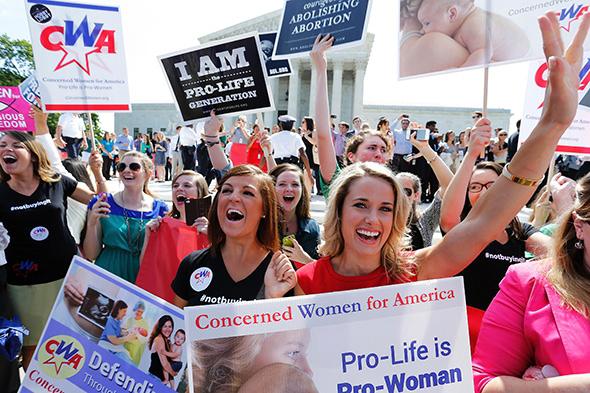It’s been a pleasure to join you all at Slate’s Breakfast Table this June. July has arrived, and so we must disband, but I want to leave you all with a few closing thoughts on what I am (cautiously) calling a not-too-pivotal term at the court. This term left us with few new certainties about the justices. Instead, it showed us a Roberts court torn among multiple potential visions of itself.
From my seat at the table, three trends defined the term. As David Cole has noted, we saw opinions noteworthy in their incrementalism—narrow holdings in McCutcheon, Harris, and McCullen (among other also-rans) that moved the law haltingly to the right but left intact important precedents. So, too, did we see a trend toward unprecedented unanimity: huge decisions on controversial issues (abortion-related speech, presidential power, privacy rights) delivered by a unified court—faux unanimous, perhaps, but unanimous nevertheless.
Lurking beneath this unanimity, as Dahlia pointed out, there emerged as well both deep divisions and an undeniable trend towards conservatism. Incrementalism, unanimity, and divisive conservatism: each a clear theme in the 2013–’14 term, all braiding together into our understanding of an increasingly complex court.
First, though many of us feared that this term the court might issue a series of blockbuster decisions eviscerating many key values and freedoms established by earlier precedents, we instead exited the last week of June sharing Emily’s feeling: “It Could Be Worse.” It’s hard to deny that nothing transformative actually happened this term. McCutcheon moved campaign finance reform laws further to the right, yet left in place Congress’ ability to regulate campaign contributions. Harris failed to overrule Abood, preserving public-sector unions, perhaps to the consternation of four justices. Despite Emily and Dahlia’s need for a break from the First Amendment, McCullen, limited sharply to its facts, left open the extent to which speech outside abortion clinics may be regulated, just as Hobby Lobby, at least for now, applies only to closely held corporations. While it hurts me to hear about the scene outside abortion clinics in the wake of McCullen, Dick, I am optimistic that the court’s decision, along with the decision in Hobby Lobby, is already motivating Democrats to continue fighting for reproductive rights in state legislatures and the court of public opinion.
Second, just as the term was defined by incrementalism, so too was it the year of unanimity. Neal Katyal pointed out last week that this court has decided cases unanimously more than 60 percent of the time—the highest percentage of unanimity since 1940. Neal argues that this is a sign of a “new consensus” among the justices; others, such as Justice Scalia in his McCullen concurrence, argue that it is a mere “specious unanimity.” And Eric thinks it’s a one-year blip. As I discussed last week, the truth is somewhere in between. On one hand, this term was not lacking in ideologically divisive cases divided along the much-criticized 5–4 lines—McCutcheon, Greece v. Galloway, Hobby Lobby, and Harris v. Quinn. So too were cases that purported to be divisive ultimately decided unanimously by the court—Bond, Riley, Lane v. Franks, McCullen, and Noel Canning. The price for unanimity in these cases may have been the narrowness of their rulings—unanimity breeds incrementalism. But unanimity—even specious unanimity—may indeed be a sign that Chief Justice Roberts is working hard to achieve the consensus he promised in his confirmation hearings.
But third, unanimity notwithstanding, there are clearly deep divisions on the court, as in the nation at large, and the wind is blowing in a conservative direction. Dahlia notes that Harris and Hobby Lobby belied the faux-nanimity of the previous week. I agree with her and others that Hobby Lobby and Harris were wrongly decided, and like my colleague Noah Feldman, I am fearful of Justice Alito’s vision for the future of religious exemptions and public-sector unions. I’ve already described how I feel about Harris. As to Hobby Lobby, I remain concerned about its scope and I don’t think that a plausible reading of the phrase “exercise of religion,” as that language appears in the Religious Freedom Restoration Act, includes what the family-owned businesses in the case were doing. Most of all, the decision does not evince sufficient sensitivity to the importance to women of often highly expensive contraceptive care.
Hobby Lobby and Harris demonstrate a consistent theme of this term: The seeds of conservative transformations lurk in the court’s narrow decisions. Will Hobby Lobby remain merely a rule for closely held corporations, or does it herald a sea change in the court’s willingness to carve gaping holes in laws of general application for failing to accommodate religious objectors? Does Harris symbolize the first chess move (or, more accurately, the second) in a game that ends with the destruction of public-sector unions? It may be too soon to tell.
In short, we cannot be sure where the court’s cautious incrementalism, “specious” unanimity, and strategic chess game will lead. Indeed, above all, the term reminds us that we must embrace, at times, our uncertainty. No single narrative—be it ideological partisanship, conservative activism, or consensus—is adequate to define a diverse set of jurists with diverse views. We should not expect otherwise.
Nor can we be certain just yet what Chief John Roberts’ true legacy will ultimately be. Cautious incrementalist, consensus-builder, or strategic conservative? We’ll have to wait until the fall to see what happens next.
